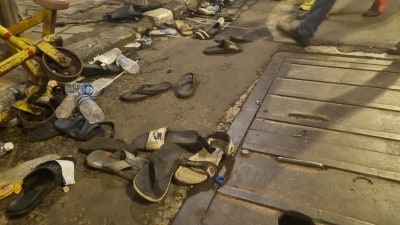- India
- International
Can SP-Congress alliance take on ‘Ram’ with ‘Samvidhan’ in eastern UP?
Both the SP and Congress have paid close attention to local issues such as inflation and rising unemployment that have created dissatisfaction among the electorate. But will communal rhetoric by the BJP once again consolidate the Hindu community and triumph over dissatisfaction over social and economic issues?
 Congress leader Rahul Gandhi and Samajwadi Party president Akhilesh Yadav during public rally for Lok Sabha polls, in Phulpur on May 19 (X/Samajwadi Party)
Congress leader Rahul Gandhi and Samajwadi Party president Akhilesh Yadav during public rally for Lok Sabha polls, in Phulpur on May 19 (X/Samajwadi Party)With the bulk of the of voting over in Uttar Pradesh, the electoral battle has shifted eastward towards Oudh, Purvanchal and Bundelkhand. Large parts of this region are backward and poverty-stricken and politics here has traditionally been different from western UP. When the 2024 elections were announced, most observers held that the BJP would repeat its 2019 performance, when it had swept most of the region with the opposition Congress, Samajwadi Party (SP) and Bahujan Samaj Party (BSP) winning only a few seats. But low voter-turnout, lack of a pro-Modi wave and the increasing importance of local issues could mean a tougher contest in the coming phases.
Akhilesh’s caste calculation
In this situation, the role played by the INDIA formation, formed in UP by the Congress and SP, will be of crucial importance. The alliance took time to be formed in UP and, in the initial part of the campaign, there were few joint rallies. It was only after Rahul Gandhi finished campaigning in Wayanad that he addressed the first joint rally with Akhilesh Yadav in Amroha on April 20. However, in May, at least six rallies of the INDIA bloc were planned, with Yadav and Gandhi holding a joint rally at Kannauj on May 10, from where the former is contesting.
Both parties have undergone much change since the 2019 elections. The driving force behind the alliance has been SP under Akhilesh, which, following the decline of BSP, has emerged as the main opposition in UP. Earlier alliances by Akhilesh with the Congress in 2017, and with the BSP in 2019, did not yield much. In the 2022 assembly election, perceiving the unhappiness of some of the smaller Dalit and OBC parties with the BJP, Akhilesh worked to remedy the Muslim-Yadav image of his party by creating an anti-BJP front with these parties. Positioning himself as the leader of the “pichde”, he shifted the election discourse into a battle between Hindutva and social justice. He also formed the Babasahib Vahini to attract Dalit votes. The SP could not defeat the BJP, but for the first time since 2014, it was able to challenge the hegemonic position of the BJP, which lost 52 seats.
In this election, a resurgent Akhilesh has distributed more tickets to diverse backward caste groups compared to the earlier Muslim-Yadav formula, in which the latter received above 40 per cent of the tickets. He has given tickets to only five Yadavs, his family members. A large number of the total 62 tickets with the SP have been allotted to influential non-Yadav backward communities. This approach was evident in the choice of candidates for seats in Basti, Pratapgarh, Gonda, Shravasti, Kushinagar, Ambedkar Nagar, Banda and Pilibhit. Similarly, in 17 reserved seats, several tickets have been allocated to the non-Jatav Dalits.
The Congress campaign
While the organisational structure of the Congress remains weak on the ground, Rahul Gandhi’s image has undergone a change with his two Bharat Jodo Yatras. The decision to contest from Rae Bareli and not Amethi was a shrewd one as it avoided a high decibel contest against Smriti Irani, leaving him free to campaign in UP. Rae Bareli is also a family bastion with a strong bond with the electorate. Most importantly, it takes the battle seriously into a state where the BJP is strong. Priyanka Gandhi Vadra is leading the campaign in Rae Bareli and Amethi, together with SP leaders. Amethi has emerged as a focal point with Amit Shah taking keen interest in the campaign.

The SP and Congress have jointly paid close attention to local issues on the ground that have created dissatisfaction among the electorate. Inflation and rising unemployment among the youth have caused disenchantment across the state. A section of the OBCs is unhappy over the BJP’s opposition to the caste census. Among Dalits, equally important is the fear of change in the Constitution, which has provided them reservation and other benefits, if the BJP returns to power. This issue, constantly reiterated by Akhilesh and Rahul Gandhi — the latter carries a copy of the Constitution to every rally — seems to have touched a chord with people. With the decline of the BSP, the smaller non-Jatav Dalits have preferred the BJP, wary of the dominant Yadavs, represented by the BJP. But with the SP joining hands with the Congress, they could view the INDIA bloc as an alternative.
The Muslim vote
There is a significant proportion of Muslims in parts of eastern UP, though their number is lower in Bundelkhand. While Mayawati has given a large number of tickets to Muslims, the alliance partners are hoping that with the Congress-SP joining hands, the community will move towards them. Seemingly worried about the impact of price rise and joblessness, many BJP leaders, including the Prime Minister, have introduced a polarising Hindu-Muslim rhetoric.
Attempts to show the Muslim community in a bad light by pointing to their numbers and allegations that Congress will redistribute wealth and constitutional guarantees to them seems to have disillusioned the community. In contrast, the Congress manifesto or Nyay Patra has been well received, particularly its promise of job guarantee and constitutional amendment to raise the 50 per cent cap on reservations for SC, ST and OBCs.
In Purvanchal, Yogi Adityanath is well entrenched, particularly among the lower castes, due to their mobilisation since the late 1990s. The strengthening of law and order under Adityanath has improved his standing. However, differences have emerged among BJP leaders over the perceived “Thakurisation” of the government and there is unease over excessive use of police force. However, the Narendra Modi and Yogi “double engine” and Modi’s candidature from Varanasi will have a major impact in the UP elections.
In Bundelkhand, once a BSP bastion, the BJP won all four seats in 2019, all 19 assembly seats in 2017 and 16 in 2022. While much development has taken place in the region, lack of promised drinking water remains a complaint. The SP has tried to reach out to the non-Yadav OBC, SC and ST voters by fielding a Dalit from Jalaun, a Lodhi from Hamirpur and a Patel from the Banda-Chitrakoot seat. The attempt is to take over the BSP’s local leadership in the region. There are reports of a well-coordinated SP-Congress campaign in most seats.
The BJP’s advantages
Despite the dissatisfaction among the electorate, the BJP is currently the best prepared party, with enormous organisational and government machinery and huge financial resources at its disposal. Major surveys show that though the popularity of Gandhi has increased, that of the PM is still unmatchable. Will INDIA be able to turn the narrative from “Ram” towards “Samvidhan”? Has the alliance been able to put together a cohesive campaign based on people’s issues apart from its call to save the Constitution? Or, will communal rhetoric by the BJP once again consolidate the Hindu community and triumph over dissatisfaction over social and economic issues? It remains to be seen.
The writer is the author (with Sajjan Kumar) of Maya, Modi, Azad: Dalit Politics in the Time of Hindutva (2023)
EXPRESS OPINION
More Explained
Jul 05: Latest News
- 0124 hours ago
- 0223 hours ago
- 0323 hours ago
- 0423 hours ago
- 051 day ago








































